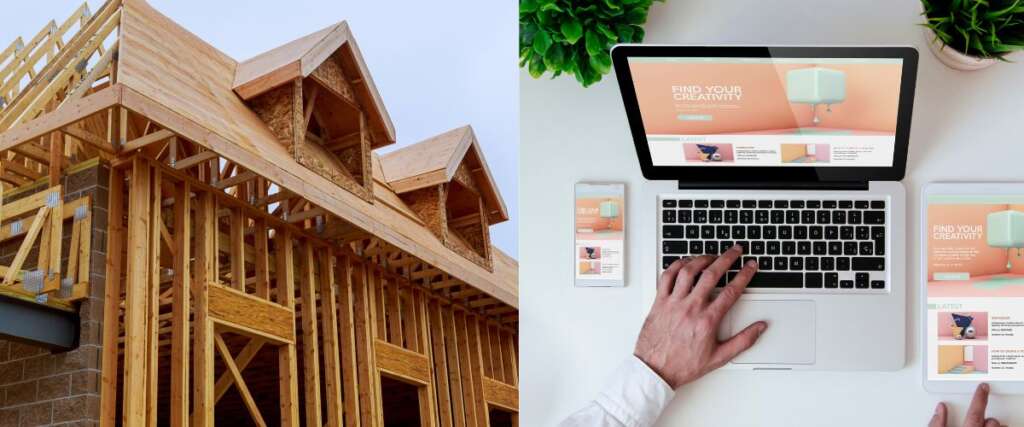A Comparative Look at the Planning, Design, and Execution Involved in Creating a Website and a Home
Introduction
At first glance, building a website and constructing a house might seem like entirely different endeavors. However, when you delve into the processes involved, you’ll find that they share several similarities. Both require careful planning, strategic design, and meticulous execution to achieve the desired outcome. In this article, we’ll explore the various stages of building a website and constructing a house, highlighting their parallels and providing insights into the creative processes behind each.
I. Laying the Groundwork: Planning and Preparation
Just as building a house begins with thorough planning and preparation, so does creating a website. In both cases, it’s crucial to:
- Define the purpose: Understand the primary goal of your website or house – be it a personal blog, an e-commerce site, a family home, or an investment property.
- Set a budget: Determine the financial resources available for the project and allocate them wisely to ensure a successful outcome.
- Choose the right team: Assemble a team of skilled professionals, such as web developers, designers, architects, and contractors, to bring your vision to fruition.
II. Architecting Your Dream: Design and Layout
Both website and house construction involve creating a blueprint or wireframe to guide the project. This stage includes:
- Designing the layout: Plan the structure and organization of your website or house, considering factors like user experience, functionality, and aesthetic appeal.
- Selecting features: Identify the essential elements you want to incorporate, such as navigation menus, content sections, rooms, or amenities.
- Planning for growth: Ensure your design allows for future expansion, whether it’s adding new content to your website or building an extension to your house.
III. Assembling the Framework: Structure and Navigation
Constructing the framework is a critical step in both website and house building processes. This involves:
- Developing the structure: Create a solid foundation and framework for your website or house, ensuring it can support the desired features and functions.
- Establishing navigation: Design clear, intuitive pathways for users to navigate your website, or for occupants to move through your house comfortably.
- Organizing content or spaces: Arrange the content sections of your website or the rooms in your house logically and efficiently to enhance user experience and functionality.
IV. Bringing Your Vision to Life: Aesthetics and Content
Once the framework is in place, it’s time to focus on aesthetics and content:
- Designing the visual elements: Select colors, fonts, and images that align with your brand or personal style for your website, or choose materials, finishes, and furnishings for your house.
- Creating engaging content: Populate your website with compelling, valuable content, or decorate your house with personal touches that reflect your tastes and preferences.
V. Ensuring Stability and Security: Quality Assurance and Testing
Before launching your website or moving into your new house, it’s essential to ensure stability and security:
- Test for functionality: Check that all features and elements of your website or house function as intended, addressing any issues or defects.
- Implement security measures: Protect your website from potential cyber threats or your house from physical risks by implementing security features, such as firewalls, SSL certificates, or
- alarm systems.
- Optimize performance: Ensure your website loads quickly and efficiently, or that your house’s systems (e.g., heating, cooling, and plumbing) operate effectively and sustainably.
- VI. Ongoing Maintenance: Updates and Improvements
- Both websites and houses require regular maintenance to keep them in top condition:
- Periodic updates: Keep your website’s content, design, and functionality up-to-date to stay relevant and engaging, or renovate your house to maintain its appeal and value.
- Monitoring and repairs: Regularly monitor your website for performance issues or security vulnerabilities, or inspect your house for structural problems or wear and tear, addressing any concerns promptly.
- Adapting to changing needs: As your personal or business needs evolve, make adjustments to your website or house to accommodate new requirements or preferences.
Conclusion
The processes of building a website and constructing a house share many similarities, from the initial planning and preparation to the design, execution, and ongoing maintenance. Both projects require a clear understanding of your goals, careful budgeting, assembling a skilled team, and meticulous attention to detail to achieve a successful outcome. By recognizing these parallels, you can gain valuable insights into the creative processes involved in bringing a website or a house to life and appreciate the hard work and dedication that goes into each endeavor.




